最新翻译批评与赏析讲义
翻译批评与赏析
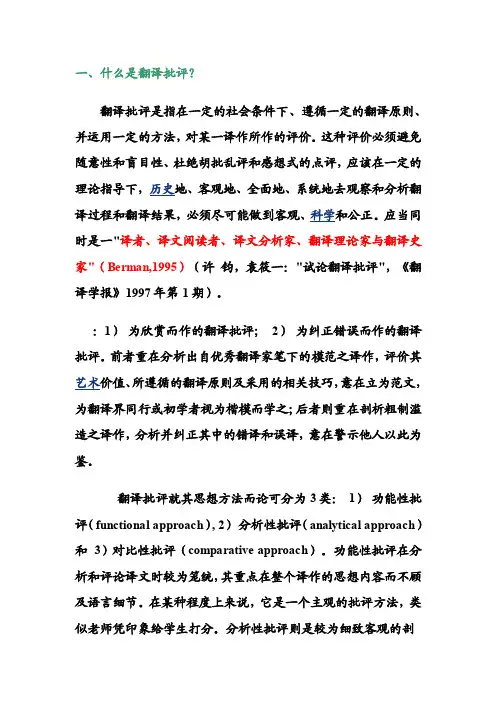
一、什么是翻译批评?翻译批评是指在一定的社会条件下、遵循一定的翻译原则、并运用一定的方法,对某一译作所作的评价。
这种评价必须避免随意性和盲目性、杜绝胡批乱评和感想式的点评,应该在一定的理论指导下,历史地、客观地、全面地、系统地去观察和分析翻译过程和翻译结果,必须尽可能做到客观、科学和公正。
应当同时是一"译者、译文阅读者、译文分析家、翻译理论家与翻译史家"(Berman,1995)(许钧,袁筱一:"试论翻译批评",《翻译学报》1997年第1期)。
:1)为欣赏而作的翻译批评;2)为纠正错误而作的翻译批评。
前者重在分析出自优秀翻译家笔下的模范之译作,评价其艺术价值、所遵循的翻译原则及采用的相关技巧,意在立为范文,为翻译界同行或初学者视为楷模而学之;后者则重在剖析粗制滥造之译作,分析并纠正其中的错译和误译,意在警示他人以此为鉴。
翻译批评就其思想方法而论可分为3类:1)功能性批评(functional approach), 2)分析性批评(analytical approach)和3)对比性批评(comparative approach)。
功能性批评在分析和评论译文时较为笼统,其重点在整个译作的思想内容而不顾及语言细节。
在某种程度上来说,它是一个主观的批评方法,类似老师凭印象给学生打分。
分析性批评则是较为细致客观的剖析,译文中的每一个词语、每一句话、每一语段和段落都会对照原文加以对比和分析,错误的译文被分门别类地挑出来加以评论,并提出改进意见;好的译文挑出来加以褒扬。
对比性批评是选择同一原作的若干种译文,同时采用译文与原文对比、译文与译文对比的方法找出各自的优劣之处。
好的加以褒奖,劣的予以批评。
翻译批评有助于克服翻译界存在的滥译、乱译等问题,因而对繁荣我国翻译事业有着不可低估的现实意义和深远的历史意义;翻译批评有助于纠正译作中出现的错误、改进不足,因而对提高译文的质量有着积极的作用;翻译批评还是联系翻译理论和翻译实践的重要桥梁,因为任何翻译理论的建立均有待于翻译实践的检验;反之,任何翻译实践都会自觉或不自觉地遵循一定的翻译理论。
翻译批评与赏析
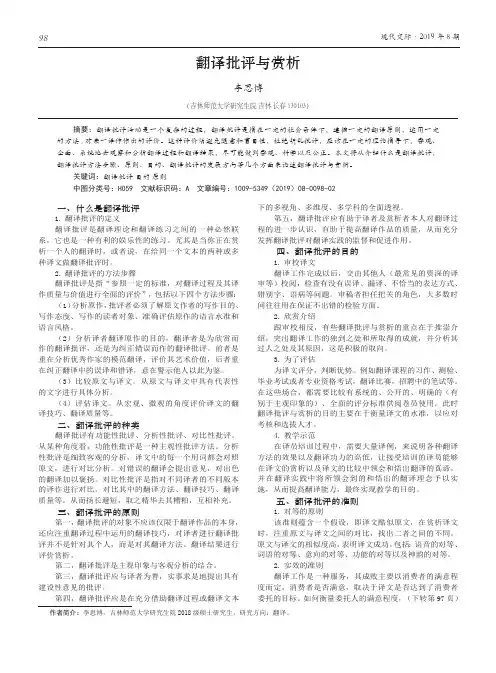
98现代交际·2019年8期作者简介:李思博,吉林师范大学研究生院2018级硕士研究生,研究方向:翻译。
翻译批评与赏析李思博(吉林师范大学研究生院 吉林 长春 130103)摘要:翻译批评活动是一个复杂的过程,翻译批评是指在一定的社会条件下,遵循一定的翻译原则,运用一定的方法,对某一译作作出的评价。
这种评价须避免随意和盲目性,杜绝胡乱批评,应该在一定的理论指导下,客观、全面、系统地去观察和分析翻译过程和翻译结果,尽可能做到客观、科学以及公正。
本文将从介绍什么是翻译批评,翻译批评方法步骤、原则、目的、翻译批评的发展方向等几个方面来论述翻译批评与赏析。
关键词:翻译批评 目的 原则中图分类号:H059 文献标识码:A 文章编号:1009-5349(2019)08-0098-02一、什么是翻译批评1.翻译批评的定义翻译批评是翻译理论和翻译练习之间的一种必然联系,它也是一种有利的娱乐性的练习。
尤其是当你正在赏析一个人的翻译时,或者说,在给同一个文本的两种或多种译文做翻译批评时。
2.翻译批评的方法步骤翻译批评是指“参照一定的标准,对翻译过程及其译作质量与价值进行全面的评价”,包括以下四个方法步骤:(1)分析原作,批评者必须了解原文作者的写作目的、写作态度、写作的读者对象、准确评估原作的语言水准和语言风格。
(2)分析译者翻译原作的目的,翻译者是为欣赏而作的翻译批评,还是为纠正错误而作的翻译批评。
前者是重在分析优秀作家的模范翻译,评价其艺术价值,后者重在纠正翻译中的误译和错译,意在警示他人以此为鉴。
(3)比较原文与译文。
从原文与译文中具有代表性的文字进行具体分析。
(4)评估译文。
从宏观、微观的角度评价译文的翻译技巧、翻译质量等。
二、翻译批评的种类翻译批评有功能性批评、分析性批评、对比性批评。
从某种角度看,功能性批评是一种主观性批评方法。
分析性批评是细致客观的分析,译文中的每一个用词都会对照原文,进行对比分析。
翻译批评及赏析长恨歌课件
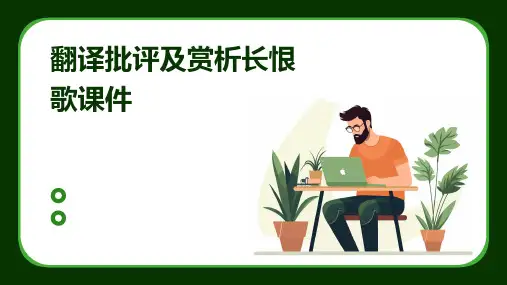
02
《长恨歌》原作赏析
《长恨歌》的创作背景
时代背景
唐朝,安史之乱前后,国家由盛 转衰,社会矛盾尖锐,唐玄宗与 杨贵妃的爱情悲剧成为诗人笔下 的创作源泉。
个人背景
白居易在长安任职期间,目睹了 统治阶级的腐朽和社会矛盾的激 化,激发了他的创作热情。
《长恨歌》的主题思想
爱情主题
描述唐玄宗与杨贵妃的爱情悲剧,批 判了统治阶级的荒淫生活。
语言风格对比
简洁风格
译文语言简练,表达清晰,易于理解。这种风格的译文在传达原文意义方面较为 准确,但在表现原文的语言美感和文化内涵方面可能有所不足。
华丽风格
译文语言华丽,修辞丰富,富有感染力。这种风格的译文能够较好地表现原文的 语言美感和文化内涵,但有时可能过于修饰,失去原文的真实性。
05
《长恨歌》的翻译策略 探讨
翻译批评及赏析长恨 歌课件
contents
目录
• 翻译批评简介 • 《长恨歌》原作赏析 • 《长恨歌》的翻译评析 • 《长恨歌》的译文对比分析 • 《长恨歌》的翻译策略探讨 • 《长恨歌》的翻译实践启示
01
翻译批评简介
翻译批评的定义
翻译批评是对翻译作品进行评估和评价的一种活动,旨在评估译文的准确性和质量 ,以及其在特定文化背景下的可接受性和影响。
形式对等与动态对等
形式对等
形式对等强调译文与原文在形式和结构上的相似性,力求保持原文的修辞和风格特点。在《长恨歌》的翻译中, 形式对等有助于保留诗歌的韵律和节奏感。
动态对等
动态对等则更注重译文的自然流畅和受众的感受,强调译文的表达效果与原文一致。在《长恨歌》的翻译中,动 态对等有助于传达诗歌的情感和主题,使译文更具有表现力和感染力。
英汉汉英对比翻译欣赏与批评课件共68页文档
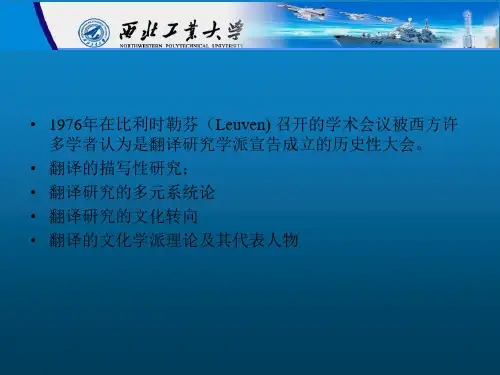
以色列学者图里和赫曼斯又对“常规”( norms)和 “翻译常规”(translation norms)进行了深入研究, 拓宽和深化了多元系统理论(Polysystem) 。
(4)他认为,以上两种情况是一个很有趣的矛盾现象: 翻译这个可以引进崭新的意念、项目、特色的媒介,竟 然成为保守传统口味的工具。
(5)他还指出,翻译文学在多系统中占主要或次要位置 ,不一定等于说整个翻译文学都处于同一个位置。
(6)翻译文学所处的位置也成为影响译者采取何种翻译 规范或方法的重要因素。
4、埃文-佐哈尔理论的价值
(1)他基本确定了翻译文学跟译入语文化文学在不同 情况下的不同关系。
(2)翻译活动实际上是由译入语文化里的各个系统所 决定。他认为,翻译不再是个其性质和界限一经确定 就不再变化的东西,而是依赖于一定文化系统中各种 关系的一种活动。他对翻译性质的新认识导致了一系 列新见解:a)把翻译看作只不过是系统间传递的一种 特殊形式,人们能以更广泛的范围来看待翻译问题。 b)人们可以把译本看作是存在在目标系统中的一个实 体,来研究它的性质,而不再纠缠于原文和译文间的 等值问题。c)人们可以从更广泛的系统间传递的角度 来认识翻译。
7、多元系统理论的影响 (1)有人探讨文艺复兴时期英格兰和苏格兰以及16世 纪西班牙的翻译文学怎样在国家文学中发挥功能。
(2)图里尝试运用此理论来探究希伯来文学的翻译, 还正式提出了以译文为中心的翻译理论。
(3)人们开始认识到:翻译的概念应该大大拓宽,尤 其是译入语文化的Байду номын сангаас点。
(4)勒弗维尔把所有直译、意译、改写、改变甚至假 “翻译”(Pseudo-translation)等都视为翻译,成 为考察对象,提出“翻译就是重写的一种形式”的论 断也受该理论影响。
英汉汉英对比翻译欣赏与批评PPT学习教案
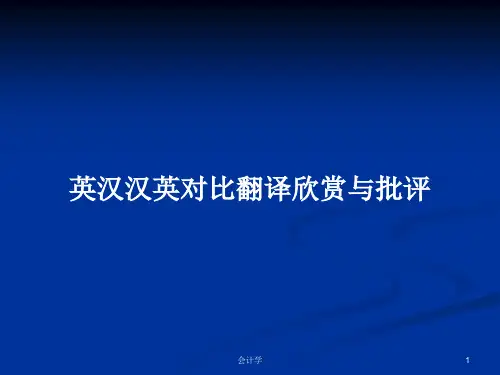
第18页/共29页
一、形式标记 着眼于音、行变异的形式标记(form markers) (一)音系标记(phonological Markers) 汉语的音系特征:元音——音乐感、实质感;声调系统——节奏感;平仄分
类——抑扬感;汉语为单音节——语音流纯净清晰,优美悦耳。 1、第一回: 假作真时真亦假,无为有处有还无。 仄仄平平平仄仄,平平仄仄仄平平。 2、第二回:贾雨村看到智通寺联: 身后有余忘缩手,眼前无路思回头。 平仄仄平仄仄仄,仄平平仄平平平。
dream”就可以算是浅化。
第8页/共29页
人闲桂花落,夜静青山空。 月出惊山鸟,时鸣春涧中。
Free and at peace. Let the sweet osmanthus shed its bloom.
Night falls and the very mountains dissolve into the void.
蜡烛有心还惜别, 替人垂泪到天明。
Even the candle, feeling our sadness,
Weeps, so we do, all night long.
Tr. Witter Bynner, 1929
The candle has a heart, it pities our separation,
第20页/共29页
(二)语域标记 (Register Markers) 按语体分,可有口语、书面语;按地域分,可有方言、标准语;按专业分,
可有种种技术用语、非技术用语;按性别分,可有女性用语、男性用语 词语的特定语域,是对常规语域的变异,行文由此显现出与核心语汇的色彩
差异。
第21页/共29页
最新翻译批评与赏析讲义
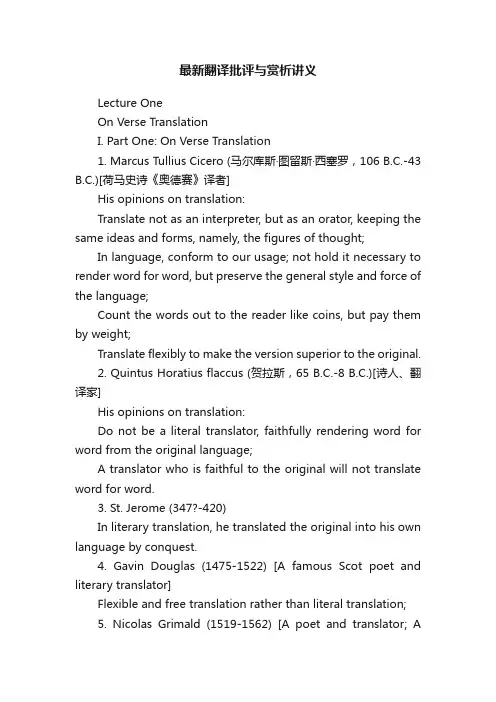
最新翻译批评与赏析讲义Lecture OneOn Verse TranslationI. Part One: On Verse Translation1. Marcus Tullius Cicero (马尔库斯·图留斯·西塞罗,106 B.C.-43B.C.)[荷马史诗《奥德赛》译者]His opinions on translation:Translate not as an interpreter, but as an orator, keeping the same ideas and forms, namely, the figures of thought;In language, conform to our usage; not hold it necessary to render word for word, but preserve the general style and force of the language;Count the words out to the reader like coins, but pay them by weight;Translate flexibly to make the version superior to the original.2. Quintus Horatius flaccus (贺拉斯,65 B.C.-8 B.C.)[诗人、翻译家]His opinions on translation:Do not be a literal translator, faithfully rendering word for word from the original language;A translator who is faithful to the original will not translate word for word.3. St. Jerome (347?-420)In literary translation, he translated the original into his own language by conquest.4. Gavin Douglas (1475-1522) [A famous Scot poet and literary translator]Flexible and free translation rather than literal translation;5. Nicolas Grimald (1519-1562) [A poet and translator; Atranslator of Cicero’s works]The Version should be as concise as the original so as to keep the complete original style;The faithfulness to the original should be the top principle of translation;6. George Chapman (1559-1634) [poet, translator of Greek classics]Against rigid word-for-word translation;Against over-free translation. (two extremes)7. Johann Wolfgang von Goethe (1749-1832)Translate the poetry in essay style;(What is the essence of poetry? Something left after the original poem has been translated into the version in the form of essay; the poetic form is nothing but shining outer ornament or decoration.)8. John Denham (1615-1669) [A famous translator in the 17th century;A poet and literary critics]No faithfulness in verse translation;Translate poetry in form of poetry;Faithful to the original meaning rather than the original form;Add something new to compensate for the loss aroused by the alteration of thetimes, languages, and places.9. Abraham Cowley (1618-1667)[An important poet, critic, and translator; Famous for his translation of pindar’s poe ms] It’s ridiculous to translate a poem literally;Recreate freely with the original theme to make the version superior or equal to the original.10. Wentworth Dillon, earl of Roscommon (1633-1685)[A poet and translator; His main contribution to translation:translation theory; Essay on translated verse.] Poetry must be translated by poets.A friendly relationship must be set between the original author and the translator; Choose the original materials of his own style to translate;Comprehend the original thoroughly, and be faithful to the essential meaning of the original without addition or distraction.11. John Dryden (1631-1700)Translation is an art;The equivalence of beauty between the original and the version12. Alexander Pope (1688-1744)A translator must be faithful to the original to the most degree;A translator should not try to surpass the original author;Equivalent to the original style;Against literal translation as well as imitation.13. William Cowper (1731-1800)[ A famous translator of Homer’s epics]Against Pope’s free style of wording;A midway between metaphrase and imitation;The highest principle of translation: faithful to the original; tightly close to the original;Against translating Homer’s epic in English rhyme pattern.14. Samuel Johnson (1709-1784)[ poet and critic]Different language is formed with different principle; hence the same expressions of the different languages do not mean the same beauty and grace all the way;The successful translation depends on the choice of the style.15. Pushkin (1799-1837)[The greate st people’s poet inRussia; a prominent representative of Russian literature in 19th century; a verse translator.]A translator must have his own freedom in the choice of original materials;A translator should enjoy sufficient freedom in translation; (imitation and adaptation);A translator must convey the original features as completely as possible.16. Rukovsky (茹科夫斯基,1783-1852)[The first true lyric poet in Russia]A verse translator should have more freedom in translation than an essay translator does; (An essay translator is a slave of the original author, while a verse translator an enemy.)A translator should only translate the original works with the same quality and flavor of his own. (Roscommom)17. Lermontov (莱蒙托夫,1814-1841)[A great poet after Pushkin]Translated freely and creatively to show the representative features of the original; The evaluation of a version depends on the literary value of the version as a Russian literary work.18. Fet (费特)[A typical representative of the pure-art poets]The artistic works have nothing to do with the people;The poetic creation should break away from the vulgar people;The wonderfulness in form cannot be separated from the genius of the work. Translate as literally as possible;19. Theodore H. Savory [A lingual scholar; his major work: The Art of Translation] Translation is an art: Literary translation as painting; scientific translation photography;His 12 descriptive principles on translation:1) A translation must give the words of the original;2) A translation must give the ideas of the original;3) A translation should read like an original work;4) A translation should read like a translation;5) A translation should reflect the style of the original;6) A translation should reflect the style of the translator;7) A translation should read as a contemporary of the original;8) A translation should read as a contemporary of the translator;9) A translation may add to or omit from the original;10) A translation may never add to or omit from the original;11) A translation of verse should be in prose;12) A translation of verse should be in verse;20. 苏曼殊:诗歌之美,在乎气体;然其情思幼眇,抑亦十方同感。
文学翻译第5-7讲文学翻译批评ppt
• 我较喜欢《幸福宝贝》,它是一件精致却 毫不华丽,彷若不曾被雕琢自然生成,那 样美丽和深沉的小摆设。它害我在公车上 流下泪来,不能自已,不是「死人冧楼」 (死人、楼宇倒下、灾难)那样的伤痛,不 是失落绝望的啜泣,不是分离的惆怅泫然, 是初次望见清晨曙光,被微风拂面时落下 的泪。
しあわせは子猫のかたち
• 大きなカメラを首からさげて、途方もなく長い小道を 彼女が歩く。両側には草原が広がり、一面が緑色。 風は温かく、運ばれるにおいに心が浮き立つ。歩み はまるで空気のように軽く、口もとは自然にほころぶ。 瞳に少年の無邪気さを宿し、高く顔をあげてこれか ら起こる冒険を待ち受ける。道ははるかに遠く、青い 空と緑の大地が接するところまで続いている。 • 她脖子上挂着一台大大的照相机,在长长的小路 上漫步,小道两旁是一望无际的草原,极目望去, 是一片绿色的海洋。柔和的清风携来花草的芬芳, 心情是多么轻松愉快。她的步履像是空气一样轻 盈,嘴角挂着甜美的笑容,眼睛里还带着少女的 天真。她仰起头来,期待着下一次的冒险旅程。 小路一直伸向远方,直到蓝天和草地相接的地平 线。
翻译中的信息流失
• 言葉の面 • 作風の面 • 文化の面
宠辱不惊,闲看庭前花开花落 去留无意,漫随天外云卷云舒
• 寵辱(ちょうじょく)、驚かず、閑(しずか)に庭前 の花開き花落つるを看(み)る。 • 去留、意なく、漫(そぞろ)に天外の雲巻き雲 舒(の)ぶるに随う。
• 菜根譚(さいこんたん)洪自誠 著 • 訳注者 今井宇三郎(いまい うさぶろう)岩 波書店1975年1月(298―299頁)
定初稿、修改核对阶段
• 初稿阶段,最重要的是忠实原作,不可脱 离原作想当然地去发挥。忠实原作也包括 对原作段落安排的忠实。慎重定初稿。 • 对译文要按照原文逐字、逐句检查,不可 脱离原文,直接修改译文。 • 条件许可的情况下,请同行或水平较高的 人来校订。
翻译鉴赏与批评
针对在职翻译人员,提供各种培训和进修课程, 以提高其翻译技能和语言水平。
自我学习与实践
鼓励翻译人员自主学习,通过大量的翻译实践提 高自己的水平。
提高翻译水平的建议
注重语言基础
提高词汇量、语法和语感,是提升翻 译水平的基础。
了解文化背景
加强对源语言和目标语言的文化背景 了解,有助于更准确地传达原文意思。
在某些领域,如法律、医学等,专业术语的翻译尤为 重要,如果缺乏专业术语,可能会造成误导。
翻译的改进建议
提高语言能力
译者应不断提高自己的语言能力,包括母语 和目标语言。
使用权威资料
在翻译专业术语时,译者应参考权威的资料 或寻求专业人士的帮助。
了解文化差异
在翻译过程中,译者应充分了解两种文化的 差异,以便更好地进行翻译。
ABCD
全球化趋势
随着全球化进程加速,翻译需求将进一步增加,涉及的 领域也将更加广泛。
持续学习与更新
翻译人员需要不断学习新知识,更新自己的语言和翻译 技能,以适应行业的发展变化。
THANKS FOR WATCHING
感谢您的观看
多次校对
译文完成后,译者应多次校对,确保没有语 言错误和文化失真。
03 翻译技巧与策略
直译与意译
直译
直译是按照原文的词句进行翻译,尽量 保留原文的表达形式和语言特征。直译 能够保留原文的文化特色和语言风格, 但有时可能显得生硬或不够流畅。
意译
意译是注重原文意思的传达,不拘泥 于原文的词句和表达形式。意译能够 使译文更加流畅易懂,但可能会损失 原文的文化特色和语言风格。
翻译是跨文化交流的桥梁,通过 翻译,不同文化背景的人们能够 相互理解和交流,感受不同文化
“翻译批评与赏析”课程教学大纲
“翻译批评与赏析”课程教学大纲一、课程基本信息开课单位:翻译学院课程名称:翻译批评与赏析课程编号:04222148英文名称:Stylistics and Translation课程类型:专业任选课总学时:32 理论学时:8学分:2开设专业:翻译专业先修课程:英汉笔译、汉英笔译二、课程任务目标(一)课程任务本课程是翻译专业学生的基础必修课程,也是学生提高翻译能力的必备课程。
本课程的任务是使学生从应用角度出发,在理论和实践上掌握各类文体的翻译方法的基础上,对翻译文本进行批评和赏析,懂得比较和欣赏译文的多样性,通过欣赏和比较不同译者的对同一原文给的不同译文,进而启发翻译实践,提高翻译能力。
同时,让学生了解开展翻译批评的重要性。
(二)课程目标在学完本课程之后,学生能够:1.掌握翻译批评的基本的理论2.掌握各类文体具体的翻译批评方法3.发现并解决翻译实践中的具体问题4.提高翻译综合能力5.了解翻译批评的重要性三、教学内容和要求(一)理论教学的内容及要求第一章翻译批评与赏析的定义1.理论与实践结合,介绍翻译批评、翻译赏析的定义;2.引导学生了解翻译批评与赏析的概念和重要性。
第四章翻译批评与赏析概论的对象与原则1. 理论与实践结合,介绍翻译批评与赏析的原则、对象;2. 引导学生掌握翻译批评与赏析的内容与原则。
第三章翻译批评与赏析的方法1. 理论与实践结合,介绍翻译批评与赏析的方法;2. 引导学生掌握翻译批评与赏析的各种具体方法及其综合利用。
第四章翻译批评与赏析的标准1. 理论与实践结合,讨论翻译批评与赏析标准的重要性;2. 回顾翻译批评标准,引导学生了解翻译的多样性以及翻译批评标准的多样性。
第五章散文翻译批评与赏析1. 理论与实践结合,引导学生掌握散文翻译批评与赏析的方法;2. 针对具体散文翻译实例,引导学生进行善意、合理的批评与赏析。
第十章小说翻译批评与赏析a) 理论与实践结合,引导学生掌握小说翻译批评与赏析的方法;b) 针对具体小说翻译实例,引导学生进行善意、合理的批评与赏析。
《翻译批评与鉴赏》教学大纲
翻译批评与鉴赏Translation Criticism and Evaluation一、课程基本情况课程类别:翻译专业任选课课程学分:2学分课程总学时:32学时,其中讲课:32学时,实验(含上机):学时,课外学时课程性质:专业选修开课学期:笫5学期先修课程:翻译理论与实践适用专业:翻译专业教材:李平、何三宁,《翻译批评与鉴赏》,北京:中央编译出版社,2014年版。
开课单位:语言文化学院英语系二、课程性质、教学目标和任务本课程为翻译专业选修课,本课程以培养学生的翻译鉴赏与批评能力为目标,旨在通过本课程的学习,懂得比拟和欣赏译文的多样性,通过欣赏和比拟不同译者的对同一原文给的不同译文,提高自身的翻译水平,同时让学生了解采用积极的、进取的态度开展翻译批评的重要性。
教学目标:1.通过大量的翻译理论学习与研究,使学生对翻译界存在争议的•些问题有比较明确的认识,树立正确的翻译批评观,学会正确对待翻译珍品中的瑕疵和错误:2.通过对名家译作的比拟与赏析,掌握翻译批评的方法,对译作要从整体上评价,看译者对原作的理解是否正确、译文的表达是否流畅以及能否再现原作的风格等;3.通过理论与实践相结合,提高学生的翻译水平与翻译鉴赏能力。
教学任务:通过教师引导-学生PPT评述-教师点评授课方式,提高学生的翻译理论与实践能力。
三、教学内容和要求第1章引论(6学时)1.1翻译批评入门(2学时)(1)了解课程的基本要求(2)理解翻译的定义、翻译的意义和地位;(3)掌握一些基本概念和思想;重点:翻译批评的定义、翻译批评的功能难点:翻译理论1.2翻译批评的原那么和方法(2学时)(1)了解翻译批评的主体和客体;(2)理解翻译批评的原那么、翻译批评的方法;(3)掌握翻译批评的基本理念;重:点:翻译批评的原那么和方法难点:翻译批评的基本理念13翻译批评史与论(2学时)(1)了解翻译批评的历史和理论;(2)理解中西方翻译家们的一此著名翻译理论;(3)掌握中外翻译家们对翻译标准的不同见解以及可译与不可译、译文可否超过原文等观占. “八、,重点:翻译的不同标准、可译与不可译之争难点:中西翻译理论第2章概念与理论(8学时)2.1翻译鉴赏(2学时)(1)了解如何进行翻译鉴赏;(2)理解翻译鉴赏的原那么和方法;(3)掌握翻译鉴赏的基本理念:重点:翻译鉴赏的原那么和方法难点:翻译鉴赏的基本理念2.2翻译评论(2学时)(1)了解如何进行翻译评论;(2)理解翻译评论的原那么和方法;(3)掌握翻译评论的基本内容和标准;重:点:翻译评论的原那么和方法难点:翻译评论的本质2.3翻译批评(2学时)(1)了解翻译批评的必要性;(2)理解如何对待翻译中的错误;(3)掌握如何写翻译批评;重点:如何写翻译批评难点:翻译批评的模式2.4翻译质量评估(2学时)(1)了解翻译质量评估的基本概念;(2)理解翻译文本的类型与功能;(3)掌握针对不同文本采用不同的翻译批评视角; 重点:文本的类型与功能难点:如何进行翻译质量评估第3章文体与应用(14学时)小说翻译批评与鉴赏(2学时)(1)了解小说的类型(2)理解小说翻译的特点;(3)掌握小说译文的赏析方法;重点:小说的类型及赏析方法难点:如何客观地评论不同译本儿童文学翻译批评与鉴赏(2学时)(1)了解儿童文学的特点(2)理解儿童文学翻译的特点;(3)掌握儿童文学译文的赏析方法;重点:儿童文学的特点及赏析方法难点:如何客观地评论不同译本散文翻译批评与鉴赏(2学时)(1)了解散文的类型(2)理解散文翻译的特点;(3)掌握散文译文的赏析方法;重点:散文的特点及赏析方法难点:如何客观地评论不同译本诗歌翻译批评与鉴赏(2学时)(1)了解诗歌的特点(2)理解诗歌翻译的特点;(3)掌握诗歌译文的赏析方法;重点:诗歌的特点及赏析方法难点:如何客观地评论不同译本科技翻译批评与鉴赏(2学时)(1)了解科技文本的特点(2)理解科技翻译的特点;(3)掌握科技译文的赏析方法;重点:科技文本的特点及赏析方法难点:如何客观地评论不同译本戏剧翻译批评与鉴赏(2学时)(1)了解戏剧文本的特点(2)理解戏剧翻译的特点;(3)掌握戏剧译文的赏析方法;重:点:戏剧的特点及赏析方法难点:如何客观地评论不同译本影视翻译批评与鉴赏(2学时)(1)了解影视的特点(2)理解影视翻译的特点;(3)掌握影视脚本的赏析方法:重点:影视翻译的特点及赏析方法难点:如何客观地评论不同译本第4章课程论文写作规范(2学时)课程论文写作(1)了解课程论文的基本要求(2)理解课程论文的格式、;(3)掌握直接引用与间接引用;重点:课程论文的写作规范难点:选题与论述第5章讨论与总结(2学时)讨论并解答学生在学习过程中遇到的问题,论文选题及引用问题等等。
- 1、下载文档前请自行甄别文档内容的完整性,平台不提供额外的编辑、内容补充、找答案等附加服务。
- 2、"仅部分预览"的文档,不可在线预览部分如存在完整性等问题,可反馈申请退款(可完整预览的文档不适用该条件!)。
- 3、如文档侵犯您的权益,请联系客服反馈,我们会尽快为您处理(人工客服工作时间:9:00-18:30)。
Lecture OneOn Verse TranslationI. Part One: On Verse Translation1. Marcus Tullius Cicero (马尔库斯·图留斯·西塞罗,106 B.C.-43 B.C.)[荷马史诗《奥德赛》译者]His opinions on translation:Translate not as an interpreter, but as an orator, keeping the same ideas and forms, namely, the figures of thought;In language, conform to our usage; not hold it necessary to render word for word, but preserve the general style and force of the language;Count the words out to the reader like coins, but pay them by weight;Translate flexibly to make the version superior to the original.2. Quintus Horatius flaccus (贺拉斯,65 B.C.-8 B.C.)[诗人、翻译家]His opinions on translation:Do not be a literal translator, faithfully rendering word for word from the original language;A translator who is faithful to the original will not translate word for word.3. St. Jerome (347?-420)In literary translation, he translated the original into his own language by conquest.4. Gavin Douglas (1475-1522) [A famous Scot poet and literary translator]Flexible and free translation rather than literal translation;5. Nicolas Grimald (1519-1562) [A poet and translator; A translator of Cicero’s works]The Version should be as concise as the original so as to keep the complete original style;The faithfulness to the original should be the top principle of translation;6. George Chapman (1559-1634) [poet, translator of Greek classics]Against rigid word-for-word translation;Against over-free translation. (two extremes)7. Johann Wolfgang von Goethe (1749-1832)Translate the poetry in essay style;(What is the essence of poetry? Something left after the original poem has been translated into the version in the form of essay; the poetic form is nothing but shining outer ornament or decoration.)8. John Denham (1615-1669) [A famous translator in the 17th century;A poet and literary critics]No faithfulness in verse translation;Translate poetry in form of poetry;Faithful to the original meaning rather than the original form;Add something new to compensate for the loss aroused by the alteration of thetimes, languages, and places.9. Abraham Cowley (1618-1667)[An important poet, critic, and translator; Famous for his translation of pindar’s poems]It’s ridiculous to translate a poem literally;Recreate freely with the original theme to make the version superior or equal to the original.10. Wentworth Dillon, earl of Roscommon (1633-1685)[A poet and translator; His main contribution to translation: translation theory; Essay on translated verse.] Poetry must be translated by poets.A friendly relationship must be set between the original author and the translator; Choose the original materials of his own style to translate;Comprehend the original thoroughly, and be faithful to the essential meaning of the original without addition or distraction.11. John Dryden (1631-1700)Translation is an art;The equivalence of beauty between the original and the version12. Alexander Pope (1688-1744)A translator must be faithful to the original to the most degree;A translator should not try to surpass the original author;Equivalent to the original style;Against literal translation as well as imitation.13. William Cowper (1731-1800)[ A famous translator of Homer’s epics]Against Pope’s free style of wording;A midway between metaphrase and imitation;The highest principle of translation: faithful to the original; tightly close to the original;Against translating Homer’s epic in English rhyme pattern.14. Samuel Johnson (1709-1784)[ poet and critic]Different language is formed with different principle; hence the same expressions of the different languages do not mean the same beauty and grace all the way;The successful translation depends on the choice of the style.15. Pushkin (1799-1837)[The greate st people’s poet in Russia; a prominent representative of Russian literature in 19th century; a verse translator.]A translator must have his own freedom in the choice of original materials;A translator should enjoy sufficient freedom in translation; (imitation and adaptation);A translator must convey the original features as completely as possible.16. Rukovsky (茹科夫斯基,1783-1852)[The first true lyric poet in Russia]A verse translator should have more freedom in translation than an essay translator does; (An essay translator is a slave of the original author, while a verse translator an enemy.)A translator should only translate the original works with the same quality and flavor of his own. (Roscommom)17. Lermontov (莱蒙托夫,1814-1841)[A great poet after Pushkin]Translated freely and creatively to show the representative features of the original; The evaluation of a version depends on the literary value of the version as a Russian literary work.18. Fet (费特)[A typical representative of the pure-art poets]The artistic works have nothing to do with the people;The poetic creation should break away from the vulgar people;The wonderfulness in form cannot be separated from the genius of the work. Translate as literally as possible;19. Theodore H. Savory [A lingual scholar; his major work: The Art of Translation] Translation is an art: Literary translation as painting; scientific translation photography;His 12 descriptive principles on translation:1) A translation must give the words of the original;2) A translation must give the ideas of the original;3) A translation should read like an original work;4) A translation should read like a translation;5) A translation should reflect the style of the original;6) A translation should reflect the style of the translator;7) A translation should read as a contemporary of the original;8) A translation should read as a contemporary of the translator;9) A translation may add to or omit from the original;10) A translation may never add to or omit from the original;11) A translation of verse should be in prose;12) A translation of verse should be in verse;20. 苏曼殊:诗歌之美,在乎气体;然其情思幼眇,抑亦十方同感。
